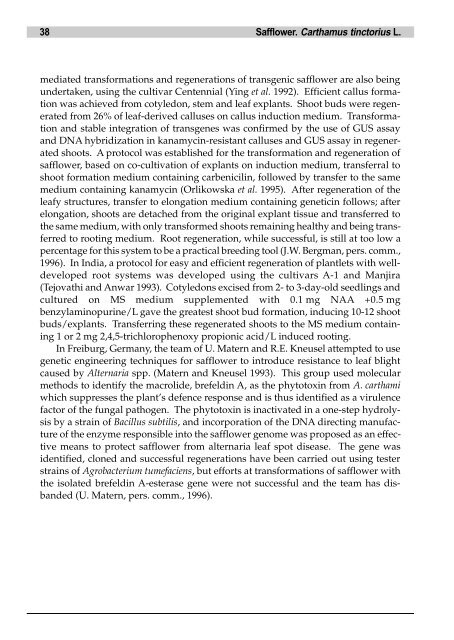Safflower, Carthamus tinctorius L. - Bioversity International
Safflower, Carthamus tinctorius L. - Bioversity International
Safflower, Carthamus tinctorius L. - Bioversity International
You also want an ePaper? Increase the reach of your titles
YUMPU automatically turns print PDFs into web optimized ePapers that Google loves.
38 <strong>Safflower</strong>. <strong>Carthamus</strong> <strong>tinctorius</strong> L.<br />
mediated transformations and regenerations of transgenic safflower are also being<br />
undertaken, using the cultivar Centennial (Ying et al. 1992). Efficient callus formation<br />
was achieved from cotyledon, stem and leaf explants. Shoot buds were regenerated<br />
from 26% of leaf-derived calluses on callus induction medium. Transformation<br />
and stable integration of transgenes was confirmed by the use of GUS assay<br />
and DNA hybridization in kanamycin-resistant calluses and GUS assay in regenerated<br />
shoots. A protocol was established for the transformation and regeneration of<br />
safflower, based on co-cultivation of explants on induction medium, transferral to<br />
shoot formation medium containing carbenicilin, followed by transfer to the same<br />
medium containing kanamycin (Orlikowska et al. 1995). After regeneration of the<br />
leafy structures, transfer to elongation medium containing geneticin follows; after<br />
elongation, shoots are detached from the original explant tissue and transferred to<br />
the same medium, with only transformed shoots remaining healthy and being transferred<br />
to rooting medium. Root regeneration, while successful, is still at too low a<br />
percentage for this system to be a practical breeding tool (J.W. Bergman, pers. comm.,<br />
1996). In India, a protocol for easy and efficient regeneration of plantlets with welldeveloped<br />
root systems was developed using the cultivars A-1 and Manjira<br />
(Tejovathi and Anwar 1993). Cotyledons excised from 2- to 3-day-old seedlings and<br />
cultured on MS medium supplemented with 0.1 mg NAA +0.5 mg<br />
benzylaminopurine/L gave the greatest shoot bud formation, inducing 10-12 shoot<br />
buds/explants. Transferring these regenerated shoots to the MS medium containing<br />
1 or 2 mg 2,4,5-trichlorophenoxy propionic acid/L induced rooting.<br />
In Freiburg, Germany, the team of U. Matern and R.E. Kneusel attempted to use<br />
genetic engineering techniques for safflower to introduce resistance to leaf blight<br />
caused by Alternaria spp. (Matern and Kneusel 1993). This group used molecular<br />
methods to identify the macrolide, brefeldin A, as the phytotoxin from A. carthami<br />
which suppresses the plant’s defence response and is thus identified as a virulence<br />
factor of the fungal pathogen. The phytotoxin is inactivated in a one-step hydrolysis<br />
by a strain of Bacillus subtilis, and incorporation of the DNA directing manufacture<br />
of the enzyme responsible into the safflower genome was proposed as an effective<br />
means to protect safflower from alternaria leaf spot disease. The gene was<br />
identified, cloned and successful regenerations have been carried out using tester<br />
strains of Agrobacterium tumefaciens, but efforts at transformations of safflower with<br />
the isolated brefeldin A-esterase gene were not successful and the team has disbanded<br />
(U. Matern, pers. comm., 1996).

















